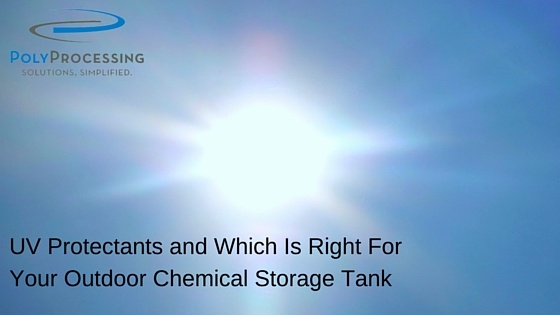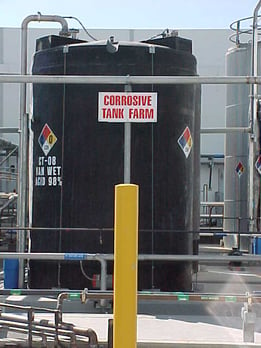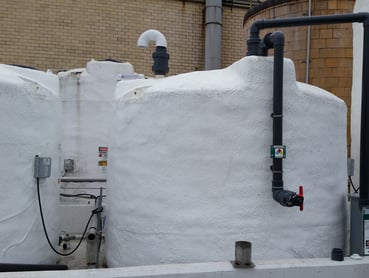UV Protectants and Which Is Right For Your Outdoor Chemical Storage Tank

Storage tanks that are used outdoors need to be protected from the elements.
Depending on the chemical being stored, and if the tank is kept outside, there are also factors to consider in order to protect the tank and its contents.
UV Protectants and Inhibitors Explained
The most common way to protect a tank from environmental factors like UV rays is to compound protectants into the plastic when the tank is made.
These UV protectants, or inhibitors are vital, particularly in areas of the country where the direct sunshine is a much bigger concern. All tank resin materials come with UV protectants built in. Poly Processing will design a tank system based on the location where it will be used. Whether the tank will be used indoors, outdoors under a cover or used outdoors in direct sunlight, we will help design the best tank using state-of-the-art UV inhibitor technology. Our goal is to give the end-user the greatest useful life possible every time we engineer a solution.
Protecting Chemical Tanks is Vital
If the tank manufacturer doesn’t use some sort of advanced protectant or inhibitor, over a short period of time the plastic will degrade and crack in the sun and that leads to a tank failure. The UV protectants keep that from happening by preventing the plastic from degrading in the sun.
Inhibitors should also be added to the plastic to protect the tank because there are certain chemicals that when heated or hit by UV rays, can degrade. The goal in using the inhibitor and UV protectant together is to block the sun and its impact completely.
Which UV Protectant or Inhibitor Should I Use For My Application?
 The first question when deciding what type of protectant or inhibitor to use is will the tank be used inside or outside.
The first question when deciding what type of protectant or inhibitor to use is will the tank be used inside or outside.
Indoor tanks don’t require as much UV protection, therefore natural or semi-translucent materials work fine.
For tanks that are stored outdoors, Carbon Black is usually recommended because it’s the best UV inhibitor known in today’s rotomolded plastics. It gives you the best of both worlds: UV inhibitors compounded into the resin as well as Carbon Black, which is compounded into the resin giving the end-user the best system for outdoor usage.
There is a misnomer out there that black tanks absorb the sun but also heat the chemical, which would degrade it over time. Studies show that in most cases, the impact is very minimal. While black tanks have a slightly higher overall temperature than natural or white tanks, the UV protection the carbon black provides outweighs the effects of slightly elevated temperature levels. The useful life of the tank is extended and the potential for catastrophic failure is reduced significantly. As a result, carbon black is the preferred compounded pigment for storing harsh chemicals such as sodium hypochlorite and other aggressive materials. The UV index value or rating of carbon black, according to an Exxonmobil study conducted over a 36 month period in the Arizona desert, supports carbon black as a superior UV resistant material.
 Another great UV protectant that can be factory applied is insulation. The insulation is applied to the tank to help maintain the temperature of the chemicals as well as protect the tank from UV and other environmental factors. The insulation is then covered in two coats of mastic latex paint.
Another great UV protectant that can be factory applied is insulation. The insulation is applied to the tank to help maintain the temperature of the chemicals as well as protect the tank from UV and other environmental factors. The insulation is then covered in two coats of mastic latex paint.
Another consideration will be how long the UV inhibitors last outdoors in normal weather. It’s hard to say for certain.It really matters which UV inhibitor package is used and what it’s matched with since there are several different resin systems that can be used. Let Poly Processing engineer the proper solution for your needs.
For more information on UV protectants and storage tanks, contact a chemical storage tank expert today.
- March 25, 2016
- Topics: Tank Design and Materials
About Poly Processing
Posts By Topic
Tech Talk Podcast Episodes
Subscribe By Email
Recent Posts
- OR-1000™: Next Generation System for Oxidizing and Corrosive Chemical Storage
- Protect Your Facility and Your Bottom Line with a Chemical Leak Detection System
- PPC Installation, Operation, and Maintenance Manual: Ensure Tank Longevity
- How To Use The Chemical Resistance Guide
- Better and Safer Alternatives to Downpipes
Tank Configurator

Find the recommended tank and system components for your chemical storage challenge.
Configure a Tank Package


